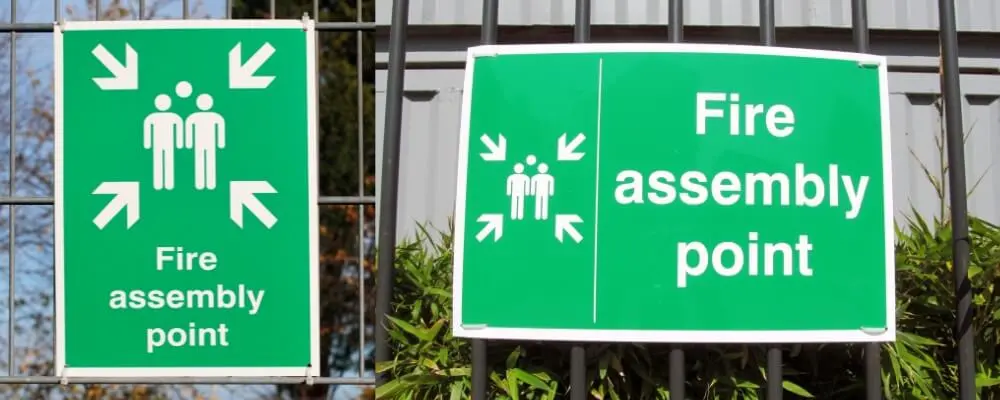Navigating emergencies in a built environment demands foresight, preparation, and clear communication. One of the pivotal elements in this safety net is the Fire Assembly Point, an oasis of order amidst potential chaos. But what is it precisely, and why is its visibility and location so crucial?
In this blog post, we delve deep into the concept of the Fire Assembly Point, exploring its definition, the significance of its signage, and the strategic considerations behind its placement. Whether you’re a facility manager, a business owner, or someone keen on understanding safety protocols, this guide promises to illuminate this vital aspect of emergency preparedness. Join us as we unravel the intricacies of ensuring safety during the most challenging moments.
What is a Fire Assembly Point? Definition
A Fire Assembly Point is a pre-determined location where individuals are instructed to gather during an emergency evacuation, primarily in the event of a fire. Its main goal is to provide a clear, organized, and safe location for all building occupants to assemble and be accounted for.

Importance of a Fire Assembly Point
- Safety: The primary goal of a Fire Assembly Point is to ensure everyone’s safety. By guiding people to a designated safe zone away from immediate hazards, the risk of injury or harm is significantly reduced.
- Accountability: With everyone gathered at a known location, it’s easier for safety officers, facility managers, or other responsible persons to quickly account for all occupants and ensure no one is missing.
- Orderly Evacuation: In emergency situations, there’s a potential for panic or disorder. Directing everyone to a specific point brings order to what could otherwise be a chaotic situation.
- Efficient Emergency Response: When first responders arrive, such as firefighters or emergency medical personnel, a centralized assembly point ensures they can quickly assess the situation, identify if anyone is injured, and determine if anyone is still inside the building.
- Clears Path for First Responders: Directing building occupants to an assembly point clears pathways and entries, ensuring that firefighters and other first responders can access the building without obstructions, facilitating a faster and more effective response.
- Reduction of Secondary Incidents: By guiding individuals away from potential hazards, secondary incidents, such as exposure to harmful substances, injuries from falling debris, or accidents due to panic, are minimized.
- Post-Emergency Procedures: Once everyone is safe, the assembly point can serve as a place to provide further instructions, communicate updates, and decide on the next steps, be it re-entry to the building or relocation.
A Fire Assembly Point is a fundamental component of emergency preparedness. Its importance extends beyond just a gathering spot – it serves as a beacon of safety, order, and organization in a confusing and dangerous situation.
Fire Assembly Point Signs

Fire assembly point signs are crucial as they indicate the direction and location of the assembly point. These signs are usually:
- Brightly colored (often green or red) for easy visibility.
- Clearly labeled with the words “Fire Assembly Point” or a similar phrase.
- Often include a pictogram of a group of people or an individual, indicating the gathering or assembly action.
- May have an arrow or directional cue guiding evacuees toward the designated safe area.
These signs should be weatherproof, resistant to fading, and positioned at an appropriate height and location for easy visibility, even in crowds.
Right Location for a Fire Assembly Point
Choosing the correct location for a fire assembly point is critical to ensure the safety of everyone in an emergency situation. Here are some considerations:
1. Away from the Building
It’s paramount that the fire assembly point is situated at a safe distance from the primary structure. The reason for this is multifold: in the event of a fire, the heat and flames can rapidly extend, and explosions are a potential risk if certain materials are present. Furthermore, falling debris poses a direct threat to individuals near the structure. The risks associated with the fire’s direct impacts, such as radiant heat and structural collapse, are mitigated by placing the assembly point away from the building.
2. Ease of Access
Accessibility is a foundational element in emergency planning. The fire assembly point should be accessible to all, including children, the elderly, and people with disabilities. Obstructions or barriers can slow down evacuation times, creating bottlenecks and potential points of congestion. This delay can result in panic and potential injury. An optimal assembly point is where people can quickly and effortlessly gather without obstructions.
3. Visible
The visibility of the assembly point cannot be stressed enough. In emergency situations, especially when there’s smoke or panic, clarity, and visibility can distinguish between swift evacuation and confusion. The assembly point should be unmistakable and easily spotted, even if visibility conditions are compromised. This minimizes people’s time searching for it and facilitates a quicker, more orderly evacuation.
4. Large Enough
The space considerations for an assembly point are directly linked to the building’s maximum occupancy. The selected area must be spacious enough to accommodate everyone without feeling cramped. Crowding can lead to discomfort, agitation, and confusion, which are undesirable during emergencies. A well-sized assembly point aids in quick headcounts ensures everyone remains comfortable, and can facilitate better organization and communication during an emergency.

5. Away from Roads or Driveways
Positioning assembly points away from active roadways or driveways safeguards evacuees from another set of risks – moving vehicles. Especially during an emergency, drivers may be distracted or unaware of the gathering crowd, leading to potential accidents. The assembly point should be placed in an area free from vehicular traffic to ensure everyone’s safety.
6. Consider Special Areas
Every facility or building may have its unique hazards. For instance, a facility storing hazardous chemicals might be at risk of toxic fume release during a fire. In such cases, the fire assembly point should be strategically placed upwind or in a direction that avoids exposure to these hazards. It’s crucial to evaluate the specific risks associated with a given location and ensure the assembly point is situated in the safest possible position for these risks.
7. Regular Review
Various factors related to a building or its surroundings might change over time. New constructions, landscaping, increased occupancy, or changes in stored materials might influence the suitability of the current fire assembly point. Hence, it’s vital to review the location of the assembly point periodically. Given the current circumstances, regular reviews ensure that it remains the most suitable location.
In a comprehensive view, the correct positioning of a fire assembly point is an amalgamation of various safety and logistical considerations. These points serve as life-saving hubs during emergencies, and their effective placement can significantly influence the outcome of emergency evacuations.

Essential Requirements For Fire Assembly Point
The Fire Assembly Point is a crucial component of a building’s safety infrastructure, ensuring a designated safe location for occupants during emergencies. To be effective, the fire assembly point should meet certain essential requirements:
- Visibility: The fire assembly point should be clearly visible from various points of the building and its surroundings. Proper signage that can be easily seen, even in compromised visibility conditions, should be installed.
- Accessibility: Everyone, including children, the elderly, and individuals with disabilities, should be able to reach the fire assembly point with ease. This means the path to it should be free from obstacles or barriers.
- Safe Distance from the Building: It should be located safely to avoid immediate threats from fire, smoke, explosions, or falling debris.
- Sufficient Space: The fire assembly point should be spacious enough to accommodate all occupants without crowding. This ensures comfort and facilitates an orderly headcount.
- Away from Roads and Driveways: To prevent potential accidents, it’s crucial that the fire assembly point is positioned away from main roads, driveways, or any areas with significant vehicle traffic.
- Protection from Hazards: If the building houses hazardous materials or has specific risk areas, the fire assembly point should be located in a direction that minimizes exposure to these potential dangers.
- Weatherproof Signage: Signs indicating the fire assembly point should be durable, resistant to weather elements, and not fade over time.
- Stable Ground: The surface or ground where occupants gather should be stable and free from potential trip hazards. It should also be suitable for all weather conditions, ensuring it doesn’t become muddy or slippery when wet.
- Regularly Reviewed and Updated: The location and setup of the fire assembly point should be reviewed periodically. If there are structural changes to the building, changes in occupancy, or changes in the surrounding environment, adjustments to the fire assembly point may be necessary.
- Clear Communication: Information about the location and purpose of the fire assembly point should be clearly communicated to all building occupants. Regular drills or training sessions can ensure everyone knows where to go in an emergency.
- Non-Interference with Emergency Services: The location should not impede the access or operations of emergency services like fire brigades. It should allow clear routes for firefighters and emergency vehicles.
- Well-lit: The assembly point should be well-lit for locations operating during nighttime hours or with limited natural light to aid in visibility and safety.
Establishing an effective fire assembly point is more than just designating a gathering spot. It requires careful consideration of the building’s layout, occupants, and potential hazards. Meeting these essential requirements ensures the safety and well-being of everyone during emergencies.
Conclusion
The Fire Assembly Point is a testament to our commitment to safety, order, and preparedness in the face of unforeseen emergencies. As we’ve journeyed through its definition, understood the nuances of its signage, and delved into the strategic importance of its location, it becomes clear that this isn’t just a designated spot on a map—it’s a lifeline. It’s a confluence where planning meets execution, ensuring that in the critical moments following an emergency, confusion gives way to clarity and panic to procedure.
Whether implementing safety measures in a facility or becoming more aware as an occupant, recognizing the vital role of the Fire Assembly Point is paramount. Let’s carry forward this understanding, making our environments safer and ready to respond with efficiency and unity when called upon.

